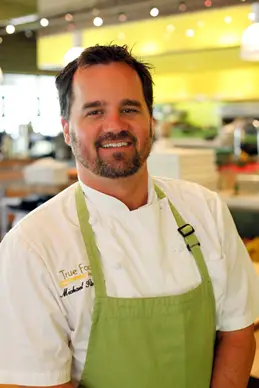 Good fats vs. bad fats, which is which, how to cook with the best ones and make appetizing dishes were the topics of an enlightening cooking class at True Food Kitchen in Newport Beach.
Good fats vs. bad fats, which is which, how to cook with the best ones and make appetizing dishes were the topics of an enlightening cooking class at True Food Kitchen in Newport Beach.
We all know that fat is bad. Consider the universe of food products that have appeared with the label “fat free.” But fat is actually essential to good health.
Understanding the difference is what Brand Executive Chef Michael Stebner made clear at his class. Even better, he prepared delicious examples in a three-course luncheon, shared the recipes and cooking tips to a full room of students recently.
"The problem is imbalance in the American diet. We get omega 6s but not enough omega 3s. Both are needed, omega 3 thins the blood and omega 6s thickens it which is needed to clot blood in an injury," Stebner explained.
Processed foods—snacks, cookies, etc, and fast food consumed now—have lots of omega 6s. As we consume more and more, our diets have become less healthy. The benefits of omega 3s, now generally recognized, have become a marketing tool for food manufacturers who add them to other products. Lowering the risk of heart disease, inflammation, and other diseases; and positive effects on brain health are just a few of the very real benefits of omega 3s.
“My opinion is adding omega 3s to food is not ideal, although I’m not opposed to it. It’s smarter to eat foods that are naturally rich in omega 3s, like flax seed, salmon and soy beans. In most cases, food with added omegas are usually processed. But some omegas are better than no omegas” Stebner said.
Chef Stebner, a 20-year kitchen veteran, learned much nutritional expertise from healthy living guru Dr. Andrew Weil. Author and director of Integrative Health & Healing at Miraval Life in Balance Resort.
When Dr. Weil wanted to open a restaurant outside the Miraval spa that served delicious health promoting dishes, he chose Sam Fox, CEO of Fox Restaurant Concepts, whose company developed 13 unique concepts with 31 restaurants in Arizona, California, Colorado, Kansas and Texas.
One of them, The Greene House in Scottsdale, features simple, inspired-by-nature dishes. Stebner was chef there and the natural choice to create the menu at the first True Food Kitchen in Phoenix. Four are currently open and five more are planned. The Newport Beach location seats 250 and serves about 1,200 to 1,500 people a day.
Stebner also discussed the Aggregate Nutrient Density Index created by Dr. Joel Fuhrman whose nutritional rating system measures the nutrients in a food. Stebner illustrated the index with two examples: kale at 1000 points and cola 1/2 point. “The scale is basically the concept of the restaurant. Most of the whole foods/ingredients present in True Food Kitchen’s dishes are very high on this scale. Kale is the highest and it’s used in salads, pizzas and sandwiches,” he said.
“Many restaurants take low quality ingredients and add butter, cream and sugar. Chefs use those as crutch for good taste,” he explained. “We don’t try to redo clam chowder or other dishes [like that],” he said. Instead, the restaurant taps healthy products to inspire orignial dishes..jpg)
On the menu the day of the class: Avocado, walnut and manchego bruschetta; grilled steelhead salmon with wok’d vegetables; kale salad with an olive oil vinaigrette; and a vegan chocolate tart made with coconut oil and almonds. The dessert was not low calorie, but the small piece served was dense, dark and satisfying.
The products used are seasonal, locally grown and organic as often as possible. “The dirty dozen have to be organic,” said Stebner referring to the produce with the highest pesticide residues. The list includes apples, bell peppers, lettuce, and strawberries. All seafood used in the kitchen is sustainable, wild or sustainably harvested.
Cooking classes are held once each quarter. The best way to find out about the next one is to join True Food Kitchen’s VIP E-Club . E-Club members find out about these classes first.
True Food Kitchen
Fashion Island
451 Newport Center Dr.
Newport Beach, CA 92660
P: 949.644.2400















